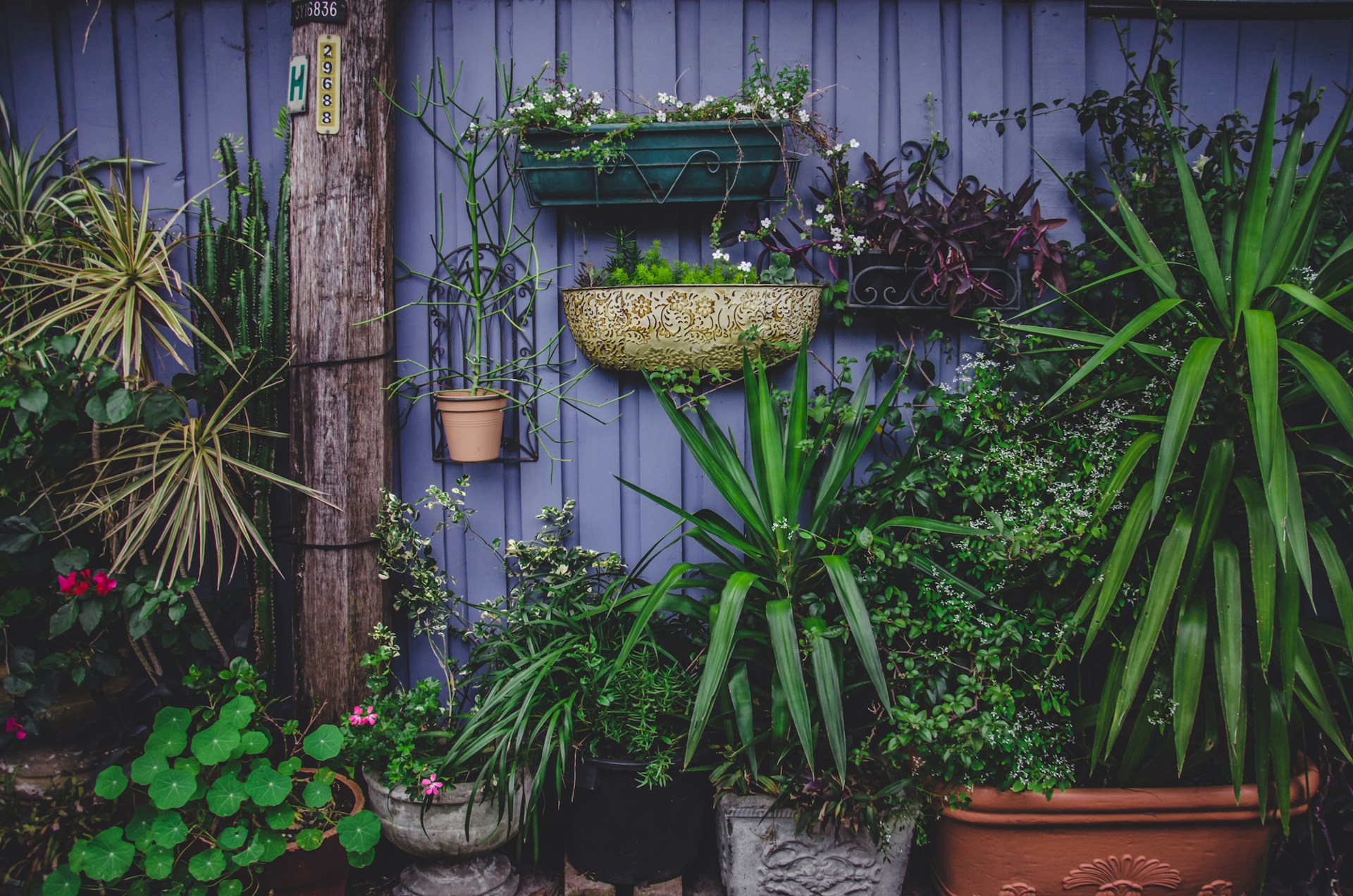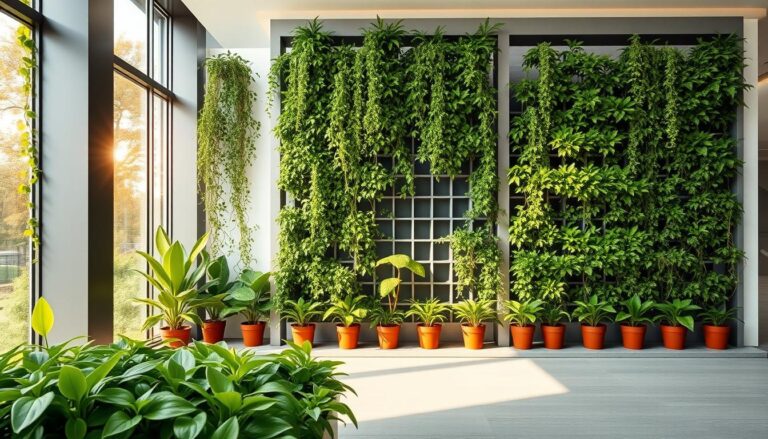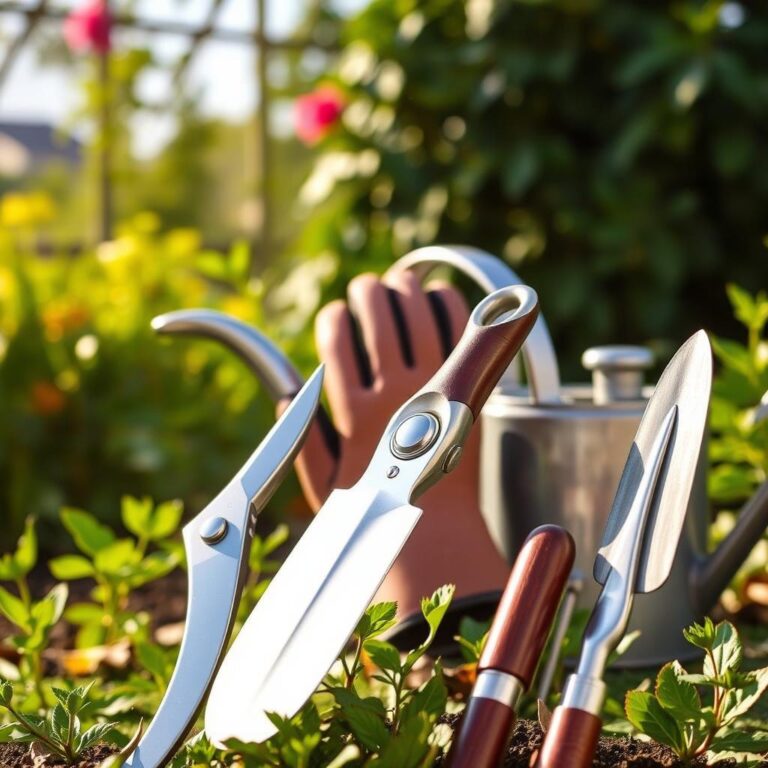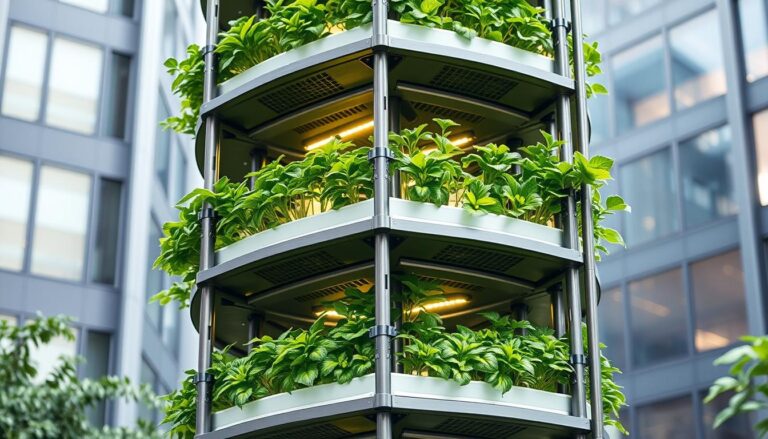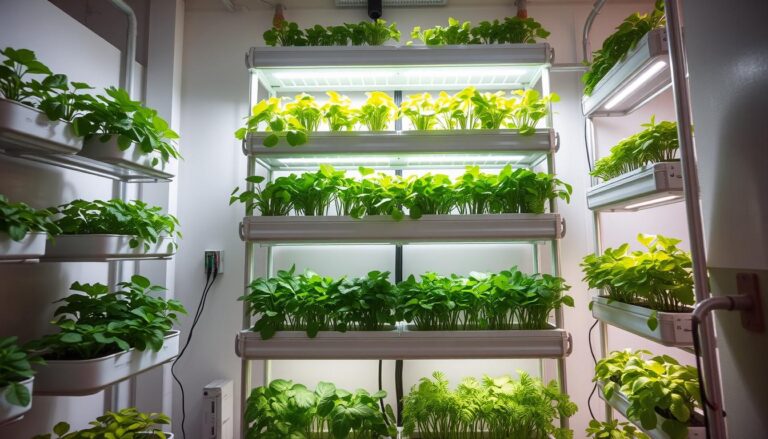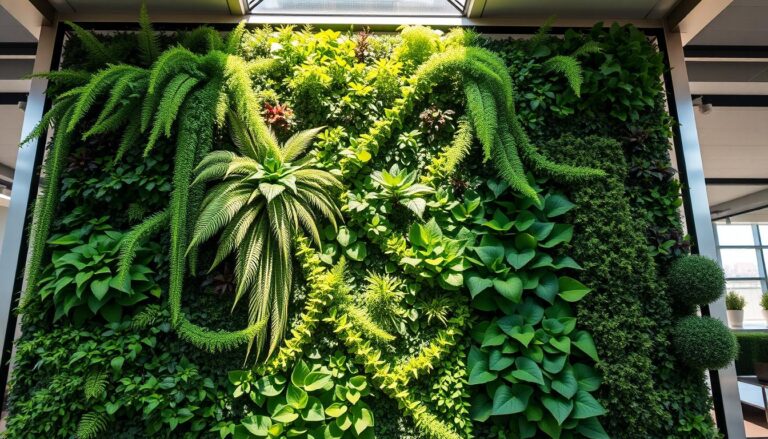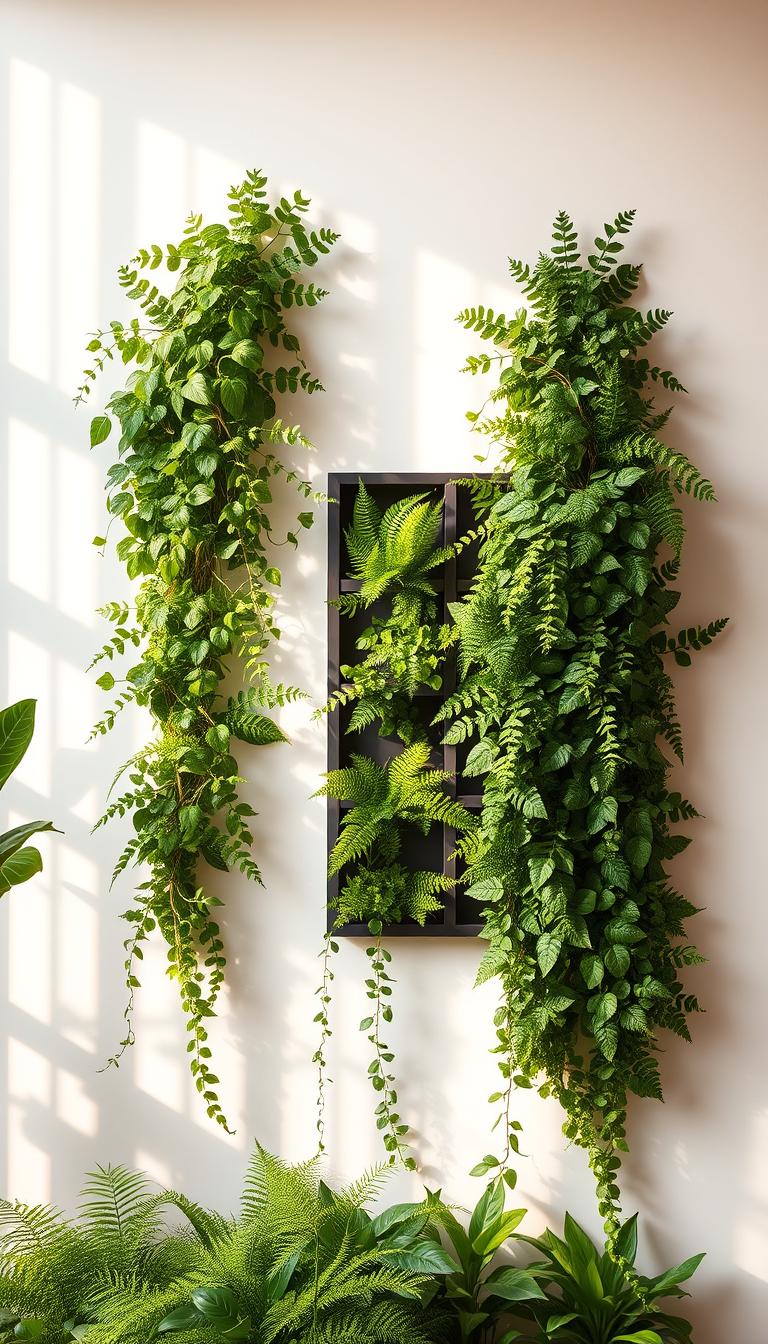Vertical Planters: Elevate Your Gardening
Ever felt frustrated by limited gardening space? Vertical planters are your ultimate solution. They turn cramped urban environments into lush, green sanctuaries. These innovative vertical gardens offer a revolutionary approach to growing plants.
Imagine turning a bare wall or tiny balcony into a thriving garden ecosystem. Vertical planters maximize every inch of available space. You can cultivate herbs, vegetables, and decorative plants where conventional gardens would be impossible. Whether you’re a city dweller with a compact apartment or a homeowner seeking creative gardening solutions, vertical gardens open up a world of green possibilities.
Modern vertical gardening isn’t just about space efficiency. These systems represent a smart, sustainable approach to urban agriculture. With ready-to-assemble kits and versatile design options, anyone can create a stunning vertical garden. It enhances both indoor and outdoor spaces.
Table of Contents
Understanding Vertical Gardening Fundamentals
Vertical gardening is a new way to use space in cities and homes. It turns walls into green spaces that grow plants. This method changes how we plant by using vertical areas.
Vertical gardens have been around since 3000 BCE. They started in the Mediterranean. Now, they help grow plants in small indoor spaces.
Basic Components of Vertical Gardens
Every vertical garden needs a few important things:
- Sturdy support structures
- Appropriate planting mediums
- Efficient irrigation systems
- Proper lighting conditions
Space-Saving Design Principles
Vertical gardening uses walls and balconies to save space. People living in cities can make small areas green and useful. This is done with smart design.
Essential Growing Conditions
Vertical gardens need the right growing conditions:
- Light exposure: Make sure there’s enough sunlight or artificial light
- Soil quality: Use light, nutrient-rich soil mixes
- Watering techniques: Keep the soil moist consistently
- Temperature control: Keep the growing area at the right temperature
Knowing these basics helps you make vertical gardens that grow well. They use space wisely and make your home better.
Benefits of Growing Plants Vertically
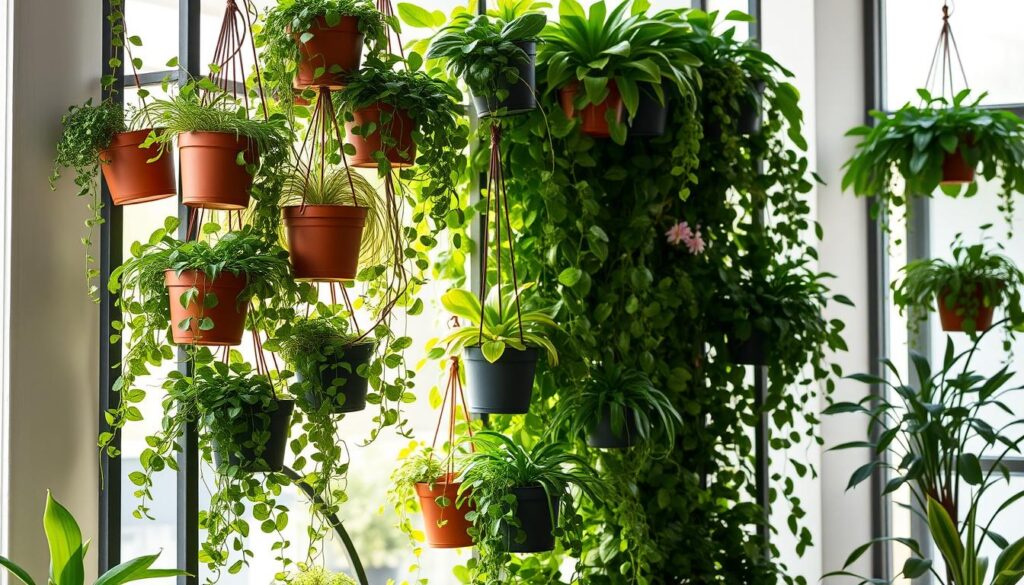
Vertical gardening changes how we grow plants, making the most of small spaces. It’s perfect for city living where regular gardens are hard to set up. Vertical planters are a smart way to grow plants well, even in tight spots.
Vertical gardens do more than save space. They bring big benefits that change how we garden:
- Space Optimization: Vertical gardens can grow up to 300% more plants than regular gardens
- Energy Efficiency: They can cool surfaces by 50 degrees, cutting down on air conditioning costs
- Environmental Impact: They add biodiversity in cities by offering food and shelter for wildlife
Vertical planters are great for plant health and growth. They keep pests away, improve air flow, and make growing conditions cleaner.
| Benefit Category | Vertical Garden Advantage |
|---|---|
| Space Efficiency | Grow 8-10 feet tall vining vegetables in minimal ground space |
| Water Conservation | Reduce water usage through targeted root irrigation |
| Plant Health | Minimize soil-borne diseases and pest interactions |
Imagine turning a blank wall into a green, thriving garden – that’s vertical gardening’s magic. It’s perfect for city balconies or suburban homes looking for new garden ideas. Vertical planters are a fun and useful way to garden.
“Vertical gardening isn’t just a technique; it’s a sustainable approach to reimagining how we grow and interact with plants.” – Urban Gardening Expert
Types of Vertical Planters and Systems
Indoor vertical gardening lets you turn your living spaces into green oases. Vertical planters are great for those with little space. They help you grow more plants in creative ways.
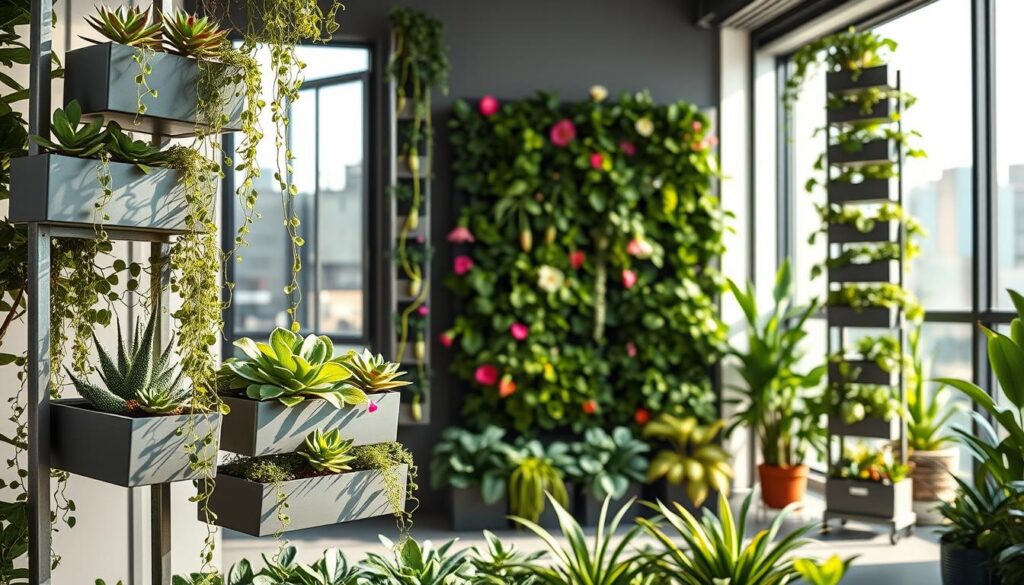
There are many vertical planters for different needs and spaces. Let’s look at the top systems for a thriving indoor garden:
Wall-Mounted Solutions
Wall-mounted planters add elegance to your home with greenery. They include:
- Pocket planters with multiple fabric compartments
- Modular wall systems with interchangeable containers
- Living walls that create stunning green backdrops
Freestanding Structures
Freestanding systems offer flexibility for gardeners. They include:
- Tower gardens with multiple planting levels
- Vertical raised beds on wheels
- Standalone plant shelves and racks
Tiered Garden Systems
Tiered systems use space well by stacking levels. They’re ideal for indoor vertical gardening fans. You can grow herbs, veggies, and plants in small areas.
When picking planters, think about weight, watering, and sunlight. Each system has its own perks for different gardening aims.
Choosing the Right Materials for Your Vertical Garden
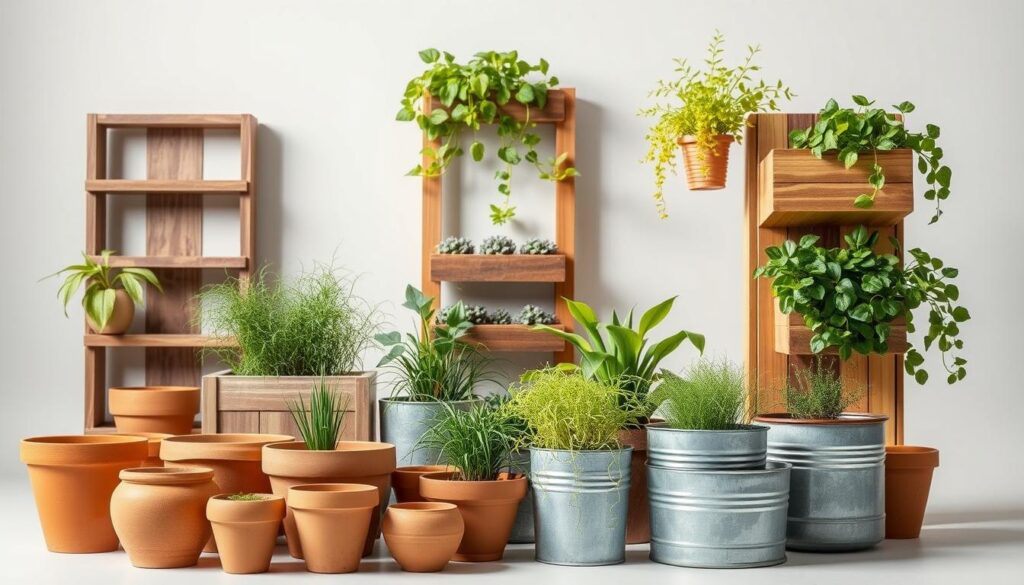
Creating a successful vertical garden starts with picking the right materials. You need something that’s strong, looks good, and keeps plants healthy. The type of vertical planters you choose will affect how well your garden does and how long it lasts.
When picking materials for your vertical planters, think about these important things:
- Structural strength to hold up plant weight
- Moisture resistance
- Environmental sustainability
- Aesthetic appeal
Wood is a favorite for vertical gardens, and for good reason. Tropical hardwoods like Ipe, Cumaru, and Teak are top choices. They offer:
- Exceptional strength for supporting plant systems
- High resistance to rot and decay
- Natural water-repellent properties
- Aesthetic appeal with diverse grain textures
Choosing sustainable lumber can also make your garden better for the planet. Brazilian Lumber’s certified wood, like Tigerwood, is a great choice. It supports forest conservation and works well for vertical gardens.
Other materials like metal, plastic, and fabric also have their perks. Metal is durable, plastic is light, and fabric lets you create flexible, modular designs.
Pro tip: Always evaluate your specific environment’s light, temperature, and moisture conditions when selecting vertical garden materials.
Your vertical planters should do more than just hold plants. They should also match your space’s style. By picking materials wisely, you’ll make a vibrant, stunning vertical garden that makes the most of small spaces.
Best Plants for Vertical Planters
Vertical planters are great for small spaces. They work well indoors or outdoors. Picking the right plants is key for a successful garden.
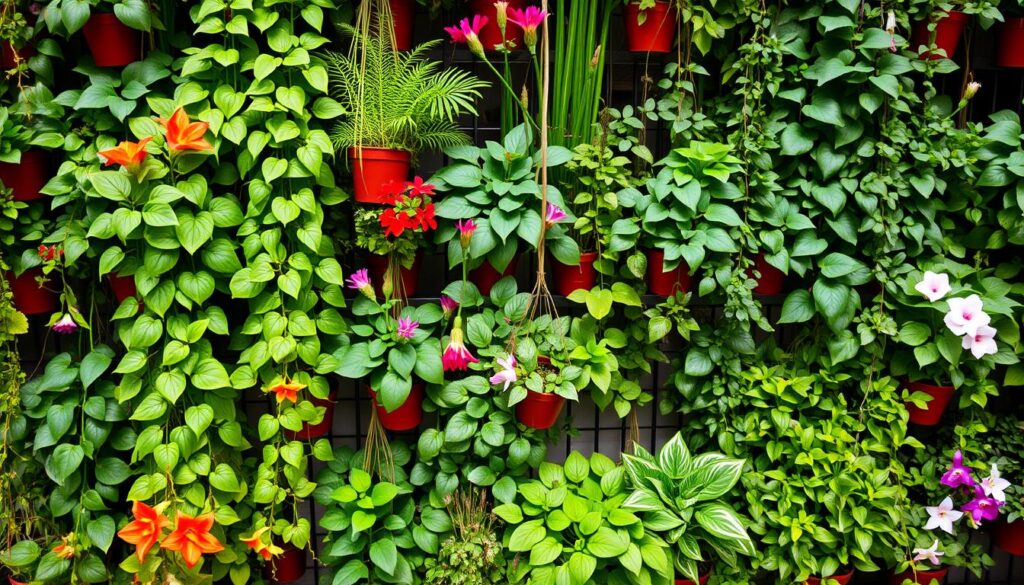
Vegetables and Herbs for Vertical Gardens
Some veggies and herbs are perfect for vertical planters. They save space and give you fresh food right there.
- Herbs: Basil, mint, cilantro, and parsley
- Leafy Greens: Lettuce, spinach, and kale
- Compact Vegetables:
- Radishes (spring and fall crops)
- Peppers (start indoors 8 weeks before planting)
- Cherry tomatoes in 24-inch diameter containers
Flowering Plants for Visual Appeal
Flowers add color and life to vertical planters. Choose varieties that fit your space and growing conditions.
- Annual Vines: Black-eyed Susan vine, morning glory
- Compact Flowering Plants: Petunias, marigolds
- Indoor Options: Orchids, ferns (prefer indirect light)
Trailing and Climbing Species
Trailing plants make vertical gardens lush and full. They can change your space indoors or outdoors.
- Succulent Varieties: Adaptable to various climates
- Climbing Vegetables: Beans (bush and pole varieties)
- Decorative Trailing Plants: String of pearls, ivy
Vertical planters need the right care. Know how much sunlight and water they need. Most veggies need 6-8 hours of sunlight. Herbs can handle some shade. Regular watering and fertilizing help your garden grow.
Setting Up Your Vertical Garden System
Vertical planters turn any space into a green oasis. They’re perfect for small balconies or big backyards. They’re a great choice for those with little room.
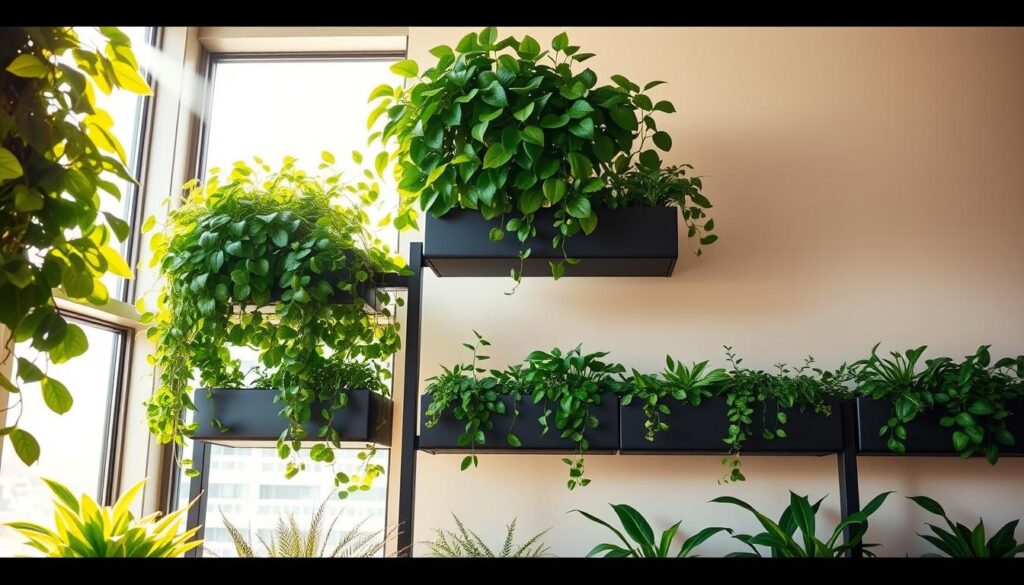
- Find a spot with enough light
- Check if you need strong support
- Pick the right planters for your space
- Make sure the mounting surface is ready
When making your vertical garden, think about what’s best for your plants. Herbs, lettuce, and annual flowers do well in vertical gardens. They need less soil and love tight spaces.
You can make your planters from old pallets, hanging racks, or special systems. Window boxes and stacked containers are great for city gardeners looking for new ideas.
- Vertical gardens save water
- Drip-irrigation systems use even less water
- They also use fewer chemicals than regular gardens
Tip: Use strong, weather-proof materials that can handle different weather. Local garden stores can help you find the perfect vertical garden setup.
Soil and Nutrition Requirements
For vertical gardens to thrive, the right soil and nutrition are key. Your vertical planters need special potting mixes and fertilizers. This ensures plants grow well in these unique setups.
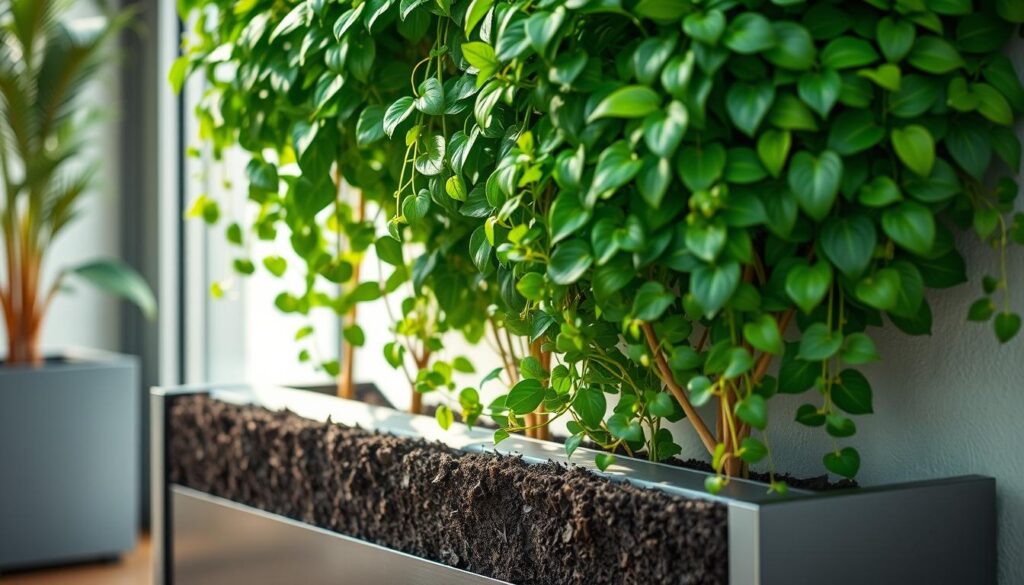
Choosing the right potting mix is vital for vertical gardens. You want a mix that’s lightweight and drains well. This helps prevent waterlogging and supports root growth in tight spaces.
Ideal Potting Mix Characteristics
- Lightweight composition
- Excellent drainage capabilities
- Rich in organic matter
- Balanced nutrient content
Fertilization Strategy
Vertical gardens need a focused nutrition plan. Studies show that controlled environments can boost crop yield and quality. Given the unique challenges of vertical planters, you must carefully manage nutrient delivery.
Nutrition Management Tips
- Use slow-release fertilizers
- Monitor nutrient absorption carefully
- Apply liquid fertilizers in smaller, more frequent doses
- Adjust nutrient mix based on specific plant needs
Pro tip: Vertical gardens can produce up to 10-20 times more crops per acre than traditional farming. So, precise nutrition management is crucial for success.
Think about using hydroponic or container-specific fertilizers. They offer balanced nutrition for your vertical gardens. Regular soil tests will help keep your growing conditions optimal and prevent nutrient shortages in your vertical planters.
Watering Systems and Maintenance
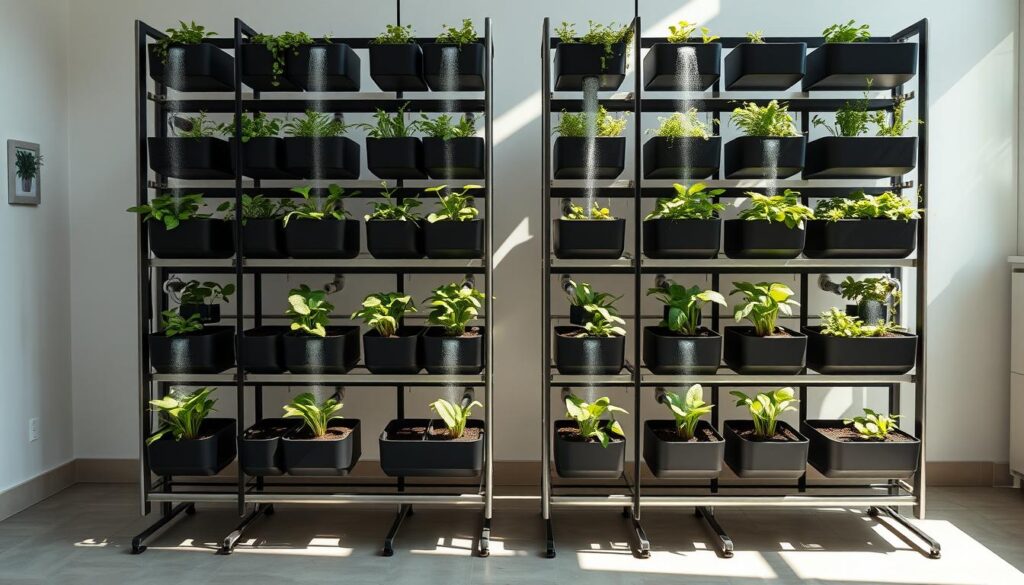
Learning how to water is key for a healthy indoor vertical garden. Vertical planters need extra care because of their design and small soil space. The right watering can keep your plants thriving.
Drip irrigation is the best way to water vertical planters. It delivers water right to the roots, saving water and preventing too much. For small gardens, follow these tips:
- Use ¼” tubing systems limited to 30 feet
- Select drippers operating at 1.6 liters per hour
- Implement modular irrigation design
Water needs change with the seasons. In summer, vertical gardens may need up to 6 liters per square meter daily, while winter demands only 1.5 liters. Watch how much water plants use to water them right.
But watering is just part of the job. You also need to:
- Check the water tank’s quality
- Clean the irrigation filters
- Watch the pH and nutrient levels
- Look for pests
Hydroponic systems can change your gardening game. They offer better control over nutrients, leading to faster growth and better results than soil.
Pro tip: Deep, infrequent watering promotes stronger root development in vertical planters.
With smart watering and regular care, your vertical garden will flourish. It will look great and make your air and life better.
Common Challenges and Solutions
Vertical gardens come with unique challenges for even the most seasoned gardeners. To keep your vertical planters thriving, you need a solid plan. Knowing these common issues helps you build strong and successful vertical gardens.
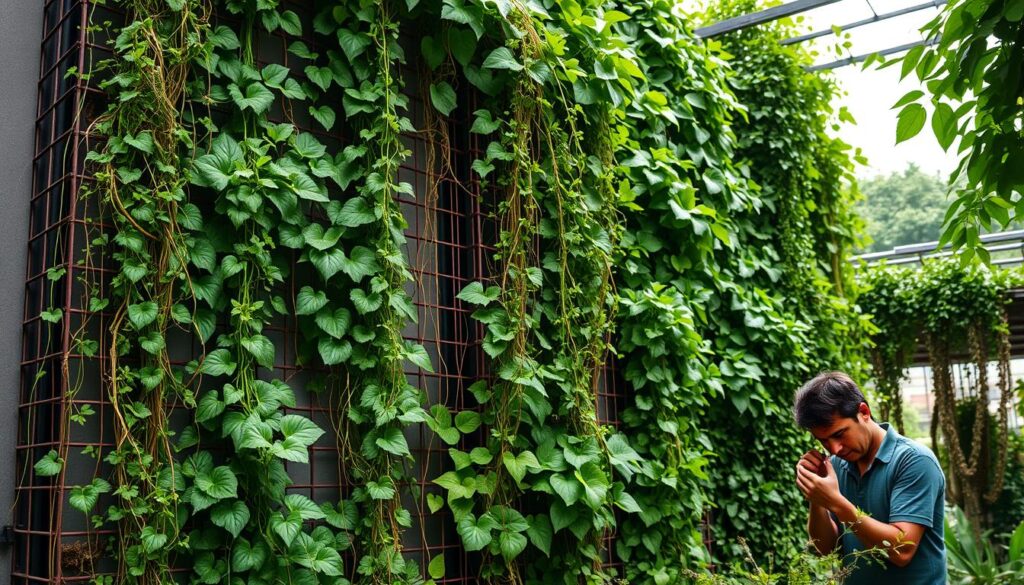
Experts say vertical planters have their own set of problems. You need to be ready with solutions. Here are the key areas to focus on:
Pest Management Strategies
Pests can quickly ruin your vertical garden. To fight them off, you need a few strategies:
- Introduce natural predators
- Try organic pest control
- Check plants often
- Keep plants far apart
Disease Prevention Techniques
To stop diseases in vertical planters, you must stay vigilant and use smart tactics:
- Make sure air flows well
- Use clean potting mix
- Keep your garden clean
- Remove sick plants fast
Structural Support Considerations
Vertical planters need strong support to hold up. They must handle plant weight and weather. Here’s how to strengthen your setup:
- Choose strong mounting tools
- Pick durable materials
- Spread out plant weight
- Check your setup often
By tackling these challenges, you can build vertical gardens that are both productive and problem-free.
Seasonal Care and Considerations
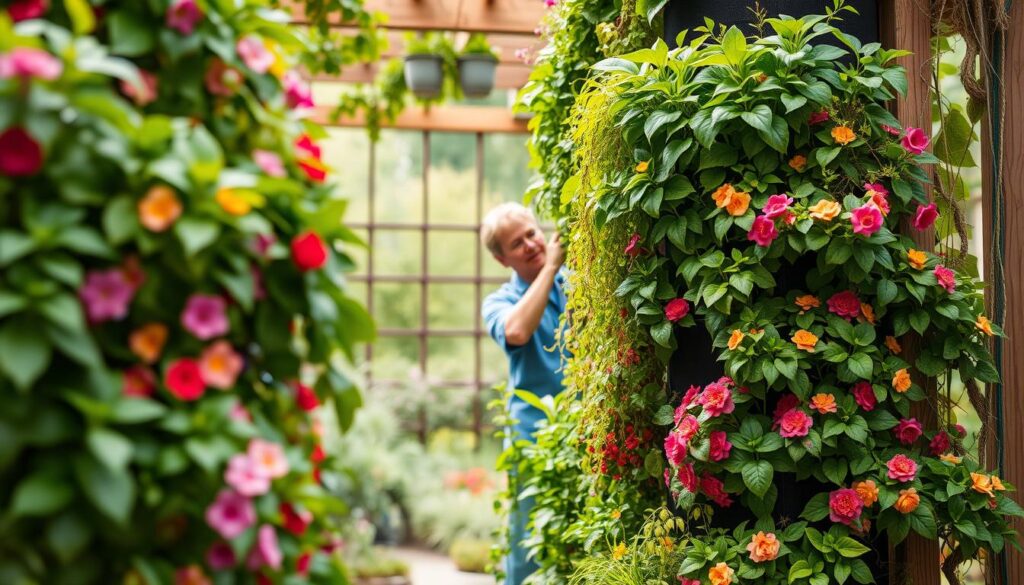
Keeping your indoor vertical garden in top shape all year round needs careful planning. Each season comes with its own set of challenges and chances for your vertical planters. You’ll need to adjust your care to keep your plants healthy and productive.
Spring is the best time to give your vertical garden a fresh start. Here’s what to focus on during this season:
- Check how your plants did over winter
- Update the potting soil
- Add new seedlings
- Make sure your planters are still sturdy
Summer brings hot weather that needs careful handling. With the heat up, your garden needs more water. Here are some tips for summer:
- Give plants shade when it’s too sunny
- Use mulch to keep moisture in
- Watch for signs of plant stress
- Try drip irrigation systems
As fall comes, you’ll need to get your garden ready for cooler weather. Choose plants like kale, spinach, and carrots that do well in cooler, less sunny spots. Water less often and protect plants from frost.
Winter care for your vertical garden is different. You’ll need to add grow lights to help with the lack of sunlight. LED grow lights are a good choice, costing about 12 cents a day if used 12 hours.
Pro tip: Rotate your vertical planters regularly to ensure even light exposure and promote balanced plant growth.
By changing your gardening approach with the seasons, you’ll keep your plants healthy and productive all year.
Conclusion
Vertical planters have changed how people grow plants in cities. They turn empty walls and ceilings into green spaces. This is great for those with little room.
Vertical gardens do more than look good. They pack more plants in a small area, clean the air, and make homes eco-friendly. You can grow herbs, succulents, or ferns in a way that fits your space.
Starting a vertical garden needs planning, care, and trying new things. Begin with a small project, learn as you go, and try different setups. With effort and creativity, your garden will flourish.
Vertical gardening is more than a hobby; it’s a way to live sustainably. It brings nature into city life. By using these methods, you help make our homes and communities greener and healthier.
Recommended products on amazon :

